哮喘、慢性阻塞性肺病和哮喘-慢性阻塞性肺病重叠患者的 HRCT 定量特征差异及其与肺功能的关系
IF 3.1
3区 医学
Q1 Medicine
International Journal of Chronic Obstructive Pulmonary Disease
Pub Date : 2024-08-01
DOI:10.2147/copd.s469956
引用次数: 0
摘要
目的:我们比较了哮喘患者、慢性阻塞性肺疾病患者和哮喘-慢性阻塞性肺疾病重叠(ACO)患者的肺功能指数和气道重塑、空气捕获和肺气肿的定量 CT 参数,并探讨了它们与气流受限的关系:我们的研究回顾性地纳入了完成肺功能测试和 HRCT 扫描的哮喘患者(48 人)、慢性阻塞性肺病患者(52 人)和 ACO 患者(30 人)以及对照组(54 人)。CT 定量分析软件用于评估肺气肿(LAA%)、气道壁尺寸(管壁面积(WA)、管腔面积(LA)和管壁面积百分比(WA%))和气潴留((- 860 HU 至 - 950 HU 的相对容积变化(RVC- 860 至 - 950)和平均肺密度的呼气吸气比(MLDE/I)))。比较了各组肺功能和 HRCT 参数的差异。利用斯皮尔曼相关分析和回归分析探讨结构与功能的关系:结果:慢性阻塞性肺病和 ACO 患者的 LAA%明显高于哮喘患者和对照组。COPD和ACO患者的WA%和WA均大于对照组,而哮喘患者和对照组的WA%和LA达到统计学意义。RVC- 860 至 - 950 水平依次下降:ACO、慢性阻塞性肺病和哮喘。哮喘患者的 RVC- 860 至 - 950 可独立预测 FEV1%;慢性阻塞性肺病患者的 LAA% 和 MLDE/I;ACO 患者的 LAA%、WA% 和 RVC- 860 至 - 950:结论:在慢性阻塞性肺病患者和 ACO 患者中观察到了相似的肺气肿,但在哮喘患者中没有观察到。所有患者都表现出近端气道重塑。慢性阻塞性肺病和 ACO 患者的支气管向外增粗,而哮喘患者的支气管向内增粗。此外,在所有组别中,ACO 患者的空气潴留最为严重。在阻塞性气道疾病中,间接肺密度测量可能比直接气道测量更能预测气流受限的程度。 关键词:哮喘;慢性阻塞性肺病;哮喘-慢性阻塞性肺病重叠;定量 HRCT;结构-功能关系本文章由计算机程序翻译,如有差异,请以英文原文为准。
Differences in the Quantitative HRCT Characteristics of Patients with Asthma, COPD and Asthma–COPD Overlap and Their Relationships with Pulmonary Function
Purpose: We compared pulmonary function indices and quantitative CT parameters of airway remodeling, air trapping, and emphysema in asthmatic patients and patients with COPD and asthma–COPD overlap (ACO) and explored their relationships with airflow limitation.
Patients and Methods: Patients with asthma (n=48), COPD (n=52), and ACO (n=30) and controls (n=54) who completed pulmonary function tests and HRCT scans were retrospectively enrolled in our study. Quantitative CT analysis software was used to assess emphysema (LAA%), airway wall dimensions (wall area (WA), luminal area (LA), and wall area percentage (WA%)), and air trapping ((relative volume change of − 860 HU to − 950 HU (RVC− 860 to-950) and the expiration-to-inspiration ratio of the mean lung density (MLDE/I))). Differences in pulmonary function and HRCT parameters were compared among the groups. Spearman correlation analysis and regression analysis were utilized to explore structure‒function relationships.
Results: The LAA% in COPD and ACO patients was significantly greater than that in asthmatic patients and controls. The WA% and WA in COPD and ACO patients were greater than those in controls, whereas the WA% and LA between asthmatic patients and controls reached statistical significance. The RVC− 860 to − 950 levels decreased in the following order: ACO, COPD, and asthma. RVC− 860 to − 950 independently predicted FEV1% in asthmatic patients; LAA% and MLDE/I in COPD patients; and LAA%, WA% and RVC− 860 to − 950 in ACO patients.
Conclusion: Comparable emphysema was observed in patients with COPD and ACO but not in asthmatic patients. All patients exhibited proximal airway remodeling. The bronchi were thickened outward in COPD and ACO patients but are thickened inward in asthmatic patients. Furthermore, air trapping in ACO patients was the most severe among all the groups. Indirect lung densitometry measurements might be more predictive of the degree of airflow limitation than direct airway measurements in obstructive airway diseases.
Keywords: asthma, COPD, asthma-COPD overlap, quantitative HRCT, structure-function relationship
Patients and Methods: Patients with asthma (n=48), COPD (n=52), and ACO (n=30) and controls (n=54) who completed pulmonary function tests and HRCT scans were retrospectively enrolled in our study. Quantitative CT analysis software was used to assess emphysema (LAA%), airway wall dimensions (wall area (WA), luminal area (LA), and wall area percentage (WA%)), and air trapping ((relative volume change of − 860 HU to − 950 HU (RVC− 860 to-950) and the expiration-to-inspiration ratio of the mean lung density (MLDE/I))). Differences in pulmonary function and HRCT parameters were compared among the groups. Spearman correlation analysis and regression analysis were utilized to explore structure‒function relationships.
Results: The LAA% in COPD and ACO patients was significantly greater than that in asthmatic patients and controls. The WA% and WA in COPD and ACO patients were greater than those in controls, whereas the WA% and LA between asthmatic patients and controls reached statistical significance. The RVC− 860 to − 950 levels decreased in the following order: ACO, COPD, and asthma. RVC− 860 to − 950 independently predicted FEV1% in asthmatic patients; LAA% and MLDE/I in COPD patients; and LAA%, WA% and RVC− 860 to − 950 in ACO patients.
Conclusion: Comparable emphysema was observed in patients with COPD and ACO but not in asthmatic patients. All patients exhibited proximal airway remodeling. The bronchi were thickened outward in COPD and ACO patients but are thickened inward in asthmatic patients. Furthermore, air trapping in ACO patients was the most severe among all the groups. Indirect lung densitometry measurements might be more predictive of the degree of airflow limitation than direct airway measurements in obstructive airway diseases.
Keywords: asthma, COPD, asthma-COPD overlap, quantitative HRCT, structure-function relationship
求助全文
通过发布文献求助,成功后即可免费获取论文全文。
去求助
来源期刊

International Journal of Chronic Obstructive Pulmonary Disease
RESPIRATORY SYSTEM-
CiteScore
5.10
自引率
10.70%
发文量
372
审稿时长
16 weeks
期刊介绍:
An international, peer-reviewed journal of therapeutics and pharmacology focusing on concise rapid reporting of clinical studies and reviews in COPD. Special focus will be given to the pathophysiological processes underlying the disease, intervention programs, patient focused education, and self management protocols. This journal is directed at specialists and healthcare professionals
 求助内容:
求助内容: 应助结果提醒方式:
应助结果提醒方式:


